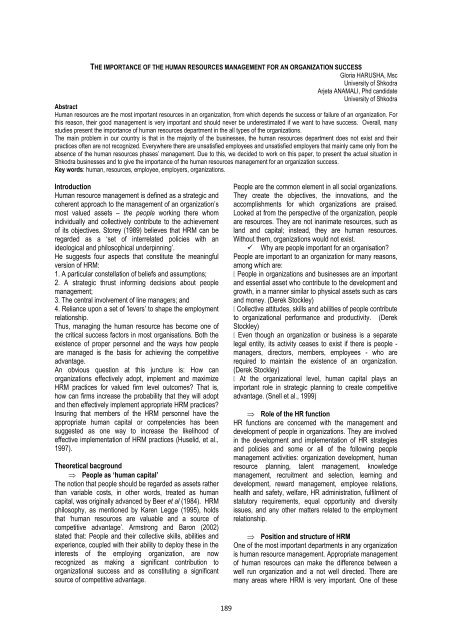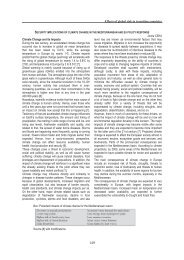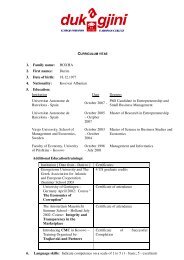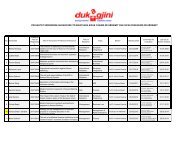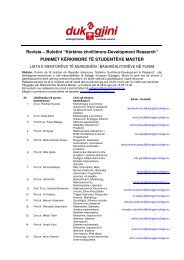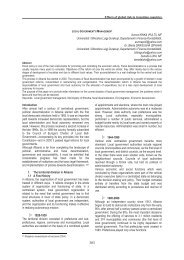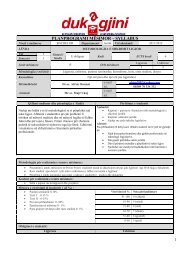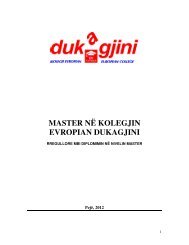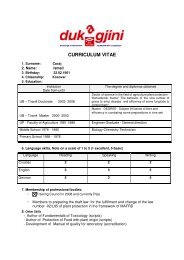189 Introduction Human resource management is defined as a ...
189 Introduction Human resource management is defined as a ...
189 Introduction Human resource management is defined as a ...
Create successful ePaper yourself
Turn your PDF publications into a flip-book with our unique Google optimized e-Paper software.
HARUSHA Gloria & ANAMALI Arjeta - The importance of the human <strong>resource</strong>s <strong>management</strong> for an organization successTHE IMPORTANCE OF THE HUMAN RESOURCES MANAGEMENT FOR AN ORGANIZATION SUCCESSGloria HARUSHA, MscUniversity of ShkodraArjeta ANAMALI, Phd candidateUniversity of ShkodraAbstract<strong>Human</strong> <strong>resource</strong>s are the most important <strong>resource</strong>s in an organization, from which depends the success or failure of an organization. Forth<strong>is</strong> re<strong>as</strong>on, their good <strong>management</strong> <strong>is</strong> very important and should never be underestimated if we want to have success. Overall, manystudies present the importance of human <strong>resource</strong>s department in the all types of the organizations.The main problem in our country <strong>is</strong> that in the majority of the businesses, the human <strong>resource</strong>s department does not ex<strong>is</strong>t and theirpractices often are not recognized. Everywhere there are unsat<strong>is</strong>fied employees and unsat<strong>is</strong>fied employers that mainly came only from theabsence of the human <strong>resource</strong>s ph<strong>as</strong>es’ <strong>management</strong>. Due to th<strong>is</strong>, we decided to work on th<strong>is</strong> paper, to present the actual situation inShkodra businesses and to give the importance of the human <strong>resource</strong>s <strong>management</strong> for an organization success.Key words: human, <strong>resource</strong>s, employee, employers, organizations.<strong>Introduction</strong><strong>Human</strong> <strong>resource</strong> <strong>management</strong> <strong>is</strong> <strong>defined</strong> <strong>as</strong> a strategic andcoherent approach to the <strong>management</strong> of an organization’smost valued <strong>as</strong>sets – the people working there whomindividually and collectively contribute to the achievementof its objectives. Storey (1989) believes that HRM can beregarded <strong>as</strong> a ‘set of interrelated policies with anideological and philosophical underpinning’.He suggests four <strong>as</strong>pects that constitute the meaningfulversion of HRM:1. A particular constellation of beliefs and <strong>as</strong>sumptions;2. A strategic thrust informing dec<strong>is</strong>ions about people<strong>management</strong>;3. The central involvement of line managers; and4. Reliance upon a set of ‘levers’ to shape the employmentrelationship.Thus, managing the human <strong>resource</strong> h<strong>as</strong> become one ofthe critical success factors in most organ<strong>is</strong>ations. Both theex<strong>is</strong>tence of proper personnel and the ways how peopleare managed <strong>is</strong> the b<strong>as</strong><strong>is</strong> for achieving the competitiveadvantage.An obvious question at th<strong>is</strong> juncture <strong>is</strong>: How canorganizations effectively adopt, implement and maximizeHRM practices for valued firm level outcomes? That <strong>is</strong>,how can firms incre<strong>as</strong>e the probability that they will adoptand then effectively implement appropriate HRM practices?Insuring that members of the HRM personnel have theappropriate human capital or competencies h<strong>as</strong> beensuggested <strong>as</strong> one way to incre<strong>as</strong>e the likelihood ofeffective implementation of HRM practices (Huselid, et al.,1997).Theoretical bacground People <strong>as</strong> ‘human capital’The notion that people should be regarded <strong>as</strong> <strong>as</strong>sets ratherthan variable costs, in other words, treated <strong>as</strong> humancapital, w<strong>as</strong> originally advanced by Beer et al (1984). HRMphilosophy, <strong>as</strong> mentioned by Karen Legge (1995), holdsthat ‘human <strong>resource</strong>s are valuable and a source ofcompetitive advantage’. Armstrong and Baron (2002)stated that: People and their collective skills, abilities andexperience, coupled with their ability to deploy these in theinterests of the employing organization, are nowrecognized <strong>as</strong> making a significant contribution toorganizational success and <strong>as</strong> constituting a significantsource of competitive advantage.People are the common element in all social organizations.They create the objectives, the innovations, and theaccompl<strong>is</strong>hments for which organizations are pra<strong>is</strong>ed.Looked at from the perspective of the organization, peopleare <strong>resource</strong>s. They are not inanimate <strong>resource</strong>s, such <strong>as</strong>land and capital; instead, they are human <strong>resource</strong>s.Without them, organizations would not ex<strong>is</strong>t. Why are people important for an organ<strong>is</strong>ation?People are important to an organization for many re<strong>as</strong>ons,among which are: People in organizations and businesses are an importantand essential <strong>as</strong>set who contribute to the development andgrowth, in a manner similar to physical <strong>as</strong>sets such <strong>as</strong> carsand money. (Derek Stockley) Collective attitudes, skills and abilities of people contributeto organizational performance and productivity. (DerekStockley) Even though an organization or business <strong>is</strong> a separatelegal entity, its activity ce<strong>as</strong>es to ex<strong>is</strong>t if there <strong>is</strong> people -managers, directors, members, employees - who arerequired to maintain the ex<strong>is</strong>tence of an organization.(Derek Stockley) At the organizational level, human capital plays animportant role in strategic planning to create competitiveadvantage. (Snell et al., 1999) Role of the HR functionHR functions are concerned with the <strong>management</strong> anddevelopment of people in organizations. They are involvedin the development and implementation of HR strategiesand policies and some or all of the following people<strong>management</strong> activities: organization development, human<strong>resource</strong> planning, talent <strong>management</strong>, knowledge<strong>management</strong>, recruitment and selection, learning anddevelopment, reward <strong>management</strong>, employee relations,health and safety, welfare, HR admin<strong>is</strong>tration, fulfilment ofstatutory requirements, equal opportunity and diversity<strong>is</strong>sues, and any other matters related to the employmentrelationship. Position and structure of HRMOne of the most important departments in any organization<strong>is</strong> human <strong>resource</strong> <strong>management</strong>. Appropriate <strong>management</strong>of human <strong>resource</strong>s can make the difference between awell run organization and a not well directed. There aremany are<strong>as</strong> where HRM <strong>is</strong> very important. One of these<strong>189</strong>
are<strong>as</strong> <strong>is</strong> for the new employees. Th<strong>is</strong> means that it <strong>is</strong> veryimportant to find the right employees for every position. It <strong>is</strong>what human <strong>resource</strong> manager devoir to ensure thatemployees are the properly selected to work in theorganization.Keeping employees <strong>is</strong> another major problem. Managerscan provide good training and incentive programs that canmotivate employees to stay longer in the organization.Individual <strong>management</strong> entails helping employees identifytheir strengths and weaknesses; correct theirshortcomings; and make their best contribution to theenterpr<strong>is</strong>e. Having a clear plan to advance to higher levelsof service will motivate workers to stay longer. The <strong>is</strong>sue ofpromotion and advancement of employees <strong>is</strong> also a major<strong>is</strong>sue. Importance of HRM <strong>is</strong> avouching in th<strong>is</strong> area.Organizations that provide ways to incre<strong>as</strong>e the position ofworkers and to provide training for workers so that theygain the necessary skills for a higher position are veryimportant for keeping the percentage of workers. It <strong>is</strong> e<strong>as</strong>yto implement the services of th<strong>is</strong> nature and cost <strong>is</strong>negligible compared with the cost and time needed to findnew employees who replace those who leave soon afterhired. Importance of human <strong>resource</strong> <strong>management</strong> inorganizations <strong>is</strong> also important in the field of servicesoffered at the employees. If they knew that employeescould go to human <strong>resource</strong>s manager whenever theyhave a problem will be e<strong>as</strong>ier for them to work consciouslyclean. Many human <strong>resource</strong>s departments implementvarious games and activities for employees that make thework environment more interesting and fun for them. Ahuman <strong>resource</strong>s manager might think different servicesthat can help employees morally. If employees are happy,the company <strong>is</strong> happy, the client also. As it can be seen,the importance of HRM <strong>is</strong> too large. HRM structures varywidely from business to business, shaped by the type, size,and governing philosophies of the organization that theyserve. But most organizations organize HRM functionsaround the clusters of people to be help they conductrecruiting, admin<strong>is</strong>trative, and other duties in a centrallocation. Different employee development groups for eachdepartment are necessary to train and develop employeesin specialized are<strong>as</strong>, such <strong>as</strong> sales, engineering,marketing, or executive education. In contr<strong>as</strong>t, some HRMdepartments are completely independent and areorganized purely by function.Th<strong>is</strong> incre<strong>as</strong>es the likelihood that HR <strong>is</strong> viewed andincluded <strong>as</strong> an integral part of the business process, similarto its marketing, finance, and operations counterparts.Research methodologyStudy aim: To give the importance of human <strong>resource</strong>sdepartment for an organization success.Research design:Secondary data cons<strong>is</strong>t on finding relevant literature on th<strong>is</strong>topic, such <strong>as</strong> books, previous studies in th<strong>is</strong> field, andmaterials from the internet. We made the selection of dataaccording to the scope of our study.Primary research cons<strong>is</strong>ts in 60-questionnaires realizedwith representatives of human <strong>resource</strong> departments ormanagers of the main entity’s, organizations (SME andlarge one) and NGO’s that operate in Shkodra city.Primary researchCurrent situation of HRM in Shkodra city enterpr<strong>is</strong>esData taken from the Tax Office shows that actually (March2012) in Shkodra city operate 975-large enterpr<strong>is</strong>es and4684 small enterpr<strong>is</strong>es.Before adding up our primary research data, being b<strong>as</strong>edon a study realized in September 2011 titled "The practiceof human <strong>resource</strong>s <strong>management</strong> <strong>is</strong> a theory or <strong>as</strong>uccessful application" Harusha G, Anamali A, we want toshow some data, which are taken from interviews withemployees of various enterpr<strong>is</strong>es, in relation to HRM intheir place of work. Th<strong>is</strong> information <strong>is</strong> presented in thetable below:QUESTIONS1. What criteria are used for your acceptance at work?2. How often do you participate in training programs?3. Did these training programs, contributed in a betterperformance at work?4. What forms of motivation are used in the organization, whereyou work?5. Does your organ<strong>is</strong>ation have human <strong>resource</strong> department?6. Do you think that the practices of human <strong>resource</strong>s<strong>management</strong> are implemented in your organ<strong>is</strong>ation?RESULTS30% - Interview20% - Testing40% - Recommendations / References10 – All criteria mentioned above30% - Once a year10% - Twice a year30% - Once in 3 years30 % - Not organized at all.40% - Yes25% - Should be improved35% - Not organized at all.20% - B<strong>as</strong>ic salary30% - Bonuses and benefits, except the b<strong>as</strong>ic salary25% - Promotions25% - All elements mentioned above45% - Yes55% - No40% - Yes60% - No190
B<strong>as</strong>ed on these data, we want to analyse some importantpoints:40% of the employees are accepted in an organ<strong>is</strong>ation onlyby a recommendation and th<strong>is</strong> <strong>is</strong> not an effective selection.As we know to hire an employee, th<strong>is</strong> have to p<strong>as</strong>s somesteps to convince the manager that he/she <strong>is</strong> the rightchoice, we can mention: review of the applicants, interview,testing, evaluation, described references and then theacceptance of the employee.The other worr<strong>is</strong>ome element <strong>is</strong> that 30% of employeesinterviewed in th<strong>is</strong> study, don’t participate in any trainingprogramme to incre<strong>as</strong>e their professional performance. Itmeans that those employees are unprepared for thenumerous changes in technology and in the external andinternal organization’s environment.55% of the employees said that, in the organ<strong>is</strong>ation thatthey work, the department of human <strong>resource</strong>s<strong>management</strong> does not ex<strong>is</strong>t. The r<strong>is</strong>ks of theseorgan<strong>is</strong>ations are very high, and we mention: unmotivatedand unsat<strong>is</strong>fied employees, low work performance, nocompetitive advantages etc. The l<strong>as</strong>t worr<strong>is</strong>ome element, <strong>is</strong>that the 60% of employees interviewed affirm that thepractices of HRM <strong>is</strong> not implemented and the re<strong>as</strong>on of th<strong>is</strong>inex<strong>is</strong>tence <strong>is</strong> that in those organizations the owner doesthe manager the financier and some other roles, insteadhe/she are not qualified in none of these functions.Once we gave these data, below we are going to show theresults of 60 questionnaires realized with representativesof human <strong>resource</strong> departments or managers of variouspublic entity, private organizations (SME and largeenterpr<strong>is</strong>es) and NGO’s, to understand what they thinkabout the importance of human <strong>resource</strong> department intheirs entity/enterpr<strong>is</strong>e. Is th<strong>is</strong> department important for anorgan<strong>is</strong>ation?QUESTIONSRESULTS1. Does the department of the human 56% - Yes<strong>resource</strong>s ex<strong>is</strong>t in your entity/ 44% - Noorgan<strong>is</strong>ation/NGO?2. Who carried out th<strong>is</strong> position? 44% - Manager of HR 66% - Other (Financier, General coordinator,no one, owner, etc.) 66% - Yes, because of the higher nr. ofemployees, to organize & coordinate thework of each department, to evaluate the3. Do you think that th<strong>is</strong> department <strong>is</strong> needfulneeds of the organization for the recruitmentfor your entity/organ<strong>is</strong>ation/NGO? Why?of the new workers 44% - No, because of the lower nr. ofworkers (small business).4. Do you use a strategy for the HRM? 80% - No 20% - Yes 44%- Interviews + Tests + References5. What ways are used to select the staff at 33% - Interviews+Testsyour entity/organization? 23% - References6. Do you organize training programs for 67% - Yesemployees in your entity/organization? 33% - No7. How often are these trainings programmes 100% - According to the needs of theorganized?organization8. What do you do to maintain the qualifiedworkers at your organization? Awareness of employees Providing a sat<strong>is</strong>factory salary. Different training to improve human skills. Rewards and promotions 25% - Promotion 22% - Rewards 15% - Comfortable working environment +9. In what form do you motivate your staff?good human relations 14% - Non - monetary bonuses 12 % - Free transport service 12% - Private life insurance 56% - Defining clearly the duties andresponsibilities of each worker10. How do you prevent the conflicts between 22% - Do not have conflictsyour staff? 22% - D<strong>is</strong>cussing together upon thespecifics of the c<strong>as</strong>e11. Does your organization have a strategy for 67% - No191
the diversification of human <strong>resource</strong>s?12. Which <strong>is</strong> your Institution/ organization’sstrong point?13. Which <strong>is</strong> the organization’s weak point? 33% - Yes Focus on the “HUMAN” The work in groups Clear objectives Professional<strong>is</strong>m Qualified staff Punctuality 56% - Don’t have weak points 11% - Higher turn-over 11% - Sometimes the duties andresponsibilities are not understood 11% - The nr. of the departments related ofthe nr. of the staff 11% - Lack of office infr<strong>as</strong>tructureReferring to these dates, we can understand a lot of things.There are some points that we want to comment.If we see the first question, 44% of the interviewed ownersof the organizations said that does not ex<strong>is</strong>t the departmentof HR and they don’t think that <strong>is</strong> necessary for them,because of the lower nr of employees, and because theyare small businesses. Th<strong>is</strong> <strong>is</strong> not a good re<strong>as</strong>on! Thecompanies that do not have a proper human <strong>resource</strong>department suffer from official d<strong>is</strong>orders and lack of<strong>management</strong> in office activities. If they want to havesuccess, every organization (big or small) must have theHR department.80% of the interviewed owners confirm that, there <strong>is</strong>n’t <strong>as</strong>trategy for the HR in their organizations. Th<strong>is</strong> mean that,th<strong>is</strong> department even in some organ<strong>is</strong>ations ex<strong>is</strong>t, do notfunction <strong>as</strong> well. A HR manager h<strong>as</strong> to know the strategy ofthe company and according to th<strong>is</strong> to have a strategy ofHRM. Connected to th<strong>is</strong>, <strong>is</strong> the answer of the 11-thquestion. 67% of the interviewer affirms that in theirorgan<strong>is</strong>ation doesn’t ex<strong>is</strong>t a strategy for the diversificationof human <strong>resource</strong>s.Referring at the tenth question, 22% of the interviewedconfirm that they don’t ever have conflicts between thestaff. In fact th<strong>is</strong> <strong>is</strong> not a strong point for theseorganizations, because the conflicts develop a companyand brings new challenges for it.The l<strong>as</strong>t question regarding to the weak points, 56% don’tthink that have weak points. We think that the first weakpoint of these entity’s/organizations or NGO-s <strong>is</strong> prec<strong>is</strong>elyhiding or not recognizing these week points. Everyorganization, to have success must at first identify andanalyze their problems. ConclusionOne of the most important departments in an organization<strong>is</strong> human <strong>resource</strong> <strong>management</strong>. Appropriate <strong>management</strong>of human <strong>resource</strong>s can make the difference between awell run organization and a not well directed.In a considerable number of businesses operating inShkodra city, the department of <strong>Human</strong> Resources doesnot ex<strong>is</strong>t. These businesses that have a department of HRdo not have a specific strategy connected with theorganization’s/institution’s strategy. Should be noted thatmost of owners or managers of businesses that weinterviewed, understand the importance of a department ofHR in their organizations, but from their less experience,the practices of th<strong>is</strong> department are very little followed. Ifpracticed well, HRM brings to the organizations sustainablecompetitive advantages. RecommendationsReferring to the analyses above, our mainrecommendations for th<strong>is</strong> entity’s/ enterpr<strong>is</strong>es and NGO’sare to:1. Make HRM strategy.2. Set HRM objectives that interpret business strategyand objectives.3. Implement HRM strategy by controlling HRM planning,<strong>as</strong>sessing, recruiting etc.4. Train, educate and develop HR.5. Manage HR performance.6. Evaluate personnel and their roles.7. Monitor the impact of HR on business strategy <strong>as</strong> well<strong>as</strong> business performance.8. Monitor how well the business sat<strong>is</strong>fies it employees.Besides these points, we also want to recommend a modelof HRM related to the organization’s strategy. We think thatth<strong>is</strong> model fits with the situation of the HRM in theorganizations in Shkodra city. Th<strong>is</strong> model <strong>is</strong> called “Theparalleling planning” (Scriniv<strong>as</strong> R. Kandula, 2005 –<strong>Human</strong>Resource Management in Pract<strong>is</strong>e with 300 Models,Techniques and Tools)and it <strong>is</strong> illustrated in Fig. 1:The model clearly stipulates the progress of HR strategyformulation movement. The HRM environment and its<strong>resource</strong> allocation priority shall follow the macroenvironment and organizational <strong>resource</strong> allocation. In th<strong>is</strong>process, at every stage, HR strategy <strong>is</strong> built by seekinginput from business strategy. Th<strong>is</strong> contributes for higherlevelmutual bonding and compatibility between both ofthem.192
Bibliography1. Coro Strandberg (2009), “The role of human <strong>resource</strong> <strong>management</strong> in corporate social responsibility”.2. David Ulrich, Wayne Brockbank et al., (2008) “HR Competences: M<strong>as</strong>tery of the Intersection of People andBusinesses”.3. Den<strong>is</strong>i, AS and Griffin, RW (2001) <strong>Human</strong> Resource Management.4. Gennard, J and Kelly, J (1994) “<strong>Human</strong> Resource Management: the views of personnel directors”.5. John Dooney (2007), “SHRM Simposium on <strong>Human</strong> Capital Analytics”.6. John W. Boudreau (2003) ,“<strong>Human</strong> Resources and Organization Success”.7. K .Vijayaragavan and Y. P. Singh “Managing human <strong>resource</strong>s within extension”.8. Michael Armstrong (2006) “<strong>Human</strong> Resource Management Practice”.9. Sriniv<strong>as</strong> R. Kandula (2005) “<strong>Human</strong> Resources Management in Practice”10. Subhir Chowdhury, “The strategic <strong>Human</strong> Resource Management Model”.11. Sumita Ketkar, P.K Set, 2007, “HR Flexibility on Firm Performance: Analyses of a Multi-Level Causal Model”193


